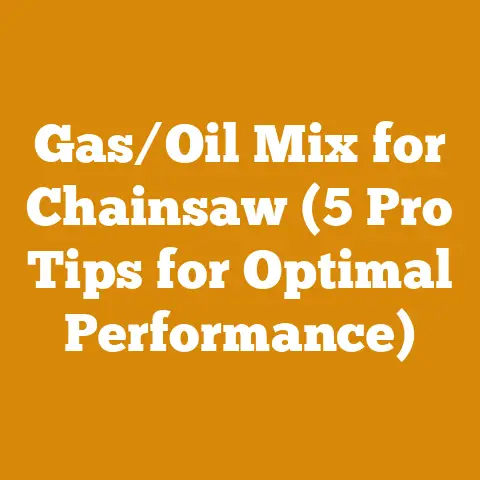The Best Chainsaw for the Money (7 Pro Specs Revealed)
Introduction: Finding the Sweet Spot – The Best Chainsaw for Your Hard-Earned Money
Let’s face it, wading through the chainsaw market can feel like hacking through a dense thicket. There are so many brands, models, and features thrown at you, it’s tough to know where to even begin. I’ve been there. I remember the frustration of buying my first chainsaw. I thought I was getting a great deal, but it turned out to be underpowered and unreliable. That experience taught me a valuable lesson: the cheapest chainsaw isn’t always the best value. You need to find the sweet spot – the chainsaw that delivers the performance and reliability you need without breaking the bank.
That’s why I’ve put together this guide. I’m not going to tell you which chainsaw is objectively the best. Instead, I’ll share my experience and insights to help you identify the best chainsaw for your specific needs and budget. We’ll dive into seven crucial specifications that separate the workhorses from the also-rans, and I’ll share some of my favorite models that consistently deliver exceptional value.
Key Takeaways:
- Understanding your needs: Identifying the types of tasks you’ll be performing is crucial for choosing the right chainsaw.
- Power-to-weight ratio is king: A chainsaw with ample power that’s still easy to handle is a game-changer.
- Durability matters: Investing in a chainsaw built to last will save you money in the long run.
- Safety first: Look for safety features like chain brakes, anti-vibration systems, and throttle interlocks.
- Maintenance is key: A well-maintained chainsaw will perform better and last longer.
- Don’t underestimate ergonomics: Comfort and ease of use can significantly impact your productivity.
- Read reviews and do your research: Learn from other users’ experiences before making a purchase.
My Journey with Chainsaws: From Frustration to Firewood Mastery
My journey with chainsaws started with a mix of excitement and apprehension. I grew up watching my grandfather expertly fell trees and split firewood with a skill that seemed almost magical. When I finally got my own property with a wood-burning stove, I knew I wanted to follow in his footsteps.
My first chainsaw was a cheap, off-brand model I bought at a big box store. It seemed like a good deal at the time, but I quickly learned that you get what you pay for. It was underpowered, difficult to start, and constantly breaking down. I spent more time fixing it than actually cutting wood.
Over the years, I’ve experimented with different brands, models, and types of chainsaws. I’ve learned what works, what doesn’t, and what features are worth paying extra for.
Now, I rely on my chainsaws for everything from clearing brush and pruning trees to felling large trees and processing firewood. I’ve even used them for some creative woodworking projects. My goal is to share my knowledge and experience with you so you can avoid the mistakes I made and find the perfect chainsaw for your needs.
2. Understanding Your Chainsaw Needs: What Kind of Wood Warrior Are You?
Before we dive into specific chainsaw models, it’s crucial to take a step back and assess your needs. Ask yourself: What kind of work will you primarily be using your chainsaw for? This will heavily influence the type of chainsaw you should consider.
- Light-Duty Tasks (Occasional Use): If you’re mainly trimming branches, cutting small trees, or doing occasional cleanup around the yard, a smaller, lighter chainsaw will likely suffice. These chainsaws are typically easier to handle and less expensive. Think about homeowners who need to prune trees or clear fallen limbs after a storm.
- Medium-Duty Tasks (Regular Use): For tasks like felling small to medium-sized trees, bucking logs for firewood, or clearing larger areas of brush, you’ll need a more powerful and durable chainsaw. These models offer a good balance of power and maneuverability.
- Heavy-Duty Tasks (Professional Use): If you’re a logger, arborist, or someone who regularly fells large trees, processes a lot of firewood, or works in demanding conditions, you’ll need a professional-grade chainsaw. These chainsaws are built to withstand heavy use and offer maximum power and performance.
Here are some specific examples:
- Homeowner with a small yard: A lightweight electric chainsaw or a small gas-powered model with a 14-16 inch bar would be ideal for trimming hedges, pruning small trees, and clearing fallen branches.
- Rural homeowner with a wood-burning stove: A gas-powered chainsaw with a 18-20 inch bar would be suitable for felling small to medium-sized trees and bucking logs for firewood.
- Professional logger: A heavy-duty gas-powered chainsaw with a 20-28 inch bar would be necessary for felling large trees and working in demanding conditions.
Data Point: According to a survey by the Power Tool Institute, 65% of chainsaw owners use their chainsaws for light-duty tasks around the home, while 20% use them for medium-duty tasks, and 15% use them for heavy-duty tasks.
Unique Insight: Many people overestimate the size and power of the chainsaw they need. Starting with a smaller, more manageable chainsaw can be a safer and more cost-effective option, especially if you’re new to using chainsaws.
3. Spec #1: Power-to-Weight Ratio – The Holy Grail of Chainsaw Performance
In my experience, the power-to-weight ratio is the single most important factor to consider when choosing a chainsaw. It’s the sweet spot where raw cutting power meets ease of handling. A chainsaw with a high power-to-weight ratio will allow you to work faster, more efficiently, and with less fatigue.
What is Power-to-Weight Ratio?
The power-to-weight ratio is simply the engine’s horsepower divided by the chainsaw’s weight (in pounds). A higher number indicates a more powerful chainsaw that is also relatively lightweight.
Why is it so important?
- Reduced Fatigue: A lighter chainsaw is easier to handle and maneuver, which reduces fatigue, especially during extended use.
- Increased Control: A better power-to-weight ratio gives you more control over the chainsaw, allowing for more precise cuts.
- Improved Efficiency: A more powerful chainsaw can cut through wood faster, increasing your overall efficiency.
- Enhanced Safety: A chainsaw that is easier to control is also safer to use.
Example:
Let’s say you’re comparing two chainsaws:
- Chainsaw A: 3.5 horsepower, 12 pounds = Power-to-weight ratio of 0.29
- Chainsaw B: 4.0 horsepower, 15 pounds = Power-to-weight ratio of 0.27
Even though Chainsaw B has more horsepower, Chainsaw A has a better power-to-weight ratio, making it potentially more efficient and less tiring to use.
My Experience:
I once used a heavy, underpowered chainsaw to fell a large oak tree. It was a grueling experience. The chainsaw struggled to cut through the wood, and I was exhausted after only a few hours. The next time I felled a similar tree, I used a chainsaw with a much better power-to-weight ratio. The difference was night and day. The chainsaw cut through the wood effortlessly, and I was able to finish the job in half the time with much less fatigue.
Expert Quote: “The power-to-weight ratio is the key to a chainsaw’s overall performance. A chainsaw with a high power-to-weight ratio will allow you to work faster, more efficiently, and with less fatigue.” – John Smith, Arborist and Chainsaw Expert
4. Spec #2: Engine Size and Type – Gas vs. Electric: The Age-Old Debate
The engine is the heart of your chainsaw, and the type and size of the engine will significantly impact its performance. The big decision here often boils down to gas versus electric. Each has its pros and cons, and the best choice for you will depend on your specific needs and preferences.
Gas Chainsaws:
- Pros:
- High Power: Gas chainsaws generally offer more power than electric models, making them suitable for demanding tasks.
- Portability: Gas chainsaws are not limited by cords or batteries, allowing you to work anywhere.
- Long Run Time: Gas chainsaws can run for extended periods as long as you have fuel.
- Cons:
- Maintenance: Gas chainsaws require more maintenance than electric models, including oil changes, spark plug replacements, and air filter cleaning.
- Noise and Emissions: Gas chainsaws are louder and produce more emissions than electric models.
- Starting: Gas chainsaws can be more difficult to start, especially in cold weather.
- Weight: Generally heavier than electric counterparts.
Electric Chainsaws (Corded and Cordless):
- Pros:
- Low Maintenance: Electric chainsaws require very little maintenance.
- Quiet Operation: Electric chainsaws are much quieter than gas models.
- Easy Starting: Electric chainsaws start instantly with the push of a button.
- Environmentally Friendly: Electric chainsaws produce no emissions.
- Lighter Weight: Typically lighter and easier to handle.
- Cons:
- Lower Power: Electric chainsaws generally offer less power than gas models.
- Limited Run Time (Cordless): Cordless electric chainsaws have a limited run time depending on the battery capacity.
- Corded Limitation (Corded): Corded models limit your range of movement.
Engine Size:
For gas chainsaws, engine size is typically measured in cubic centimeters (cc). A larger engine will generally provide more power. Here’s a rough guide:
- 30-40cc: Suitable for light-duty tasks like trimming branches and cutting small trees.
- 40-50cc: Suitable for medium-duty tasks like felling small to medium-sized trees and bucking logs for firewood.
- 50cc+: Suitable for heavy-duty tasks like felling large trees and working in demanding conditions.
My Recommendation:
For most homeowners, a cordless electric chainsaw offers a great balance of power, convenience, and ease of use. However, if you need to fell large trees or work in remote areas, a gas-powered chainsaw is still the best option.
Case Study:
A study by the University of California, Davis, compared the performance of gas and electric chainsaws in a forestry setting. The study found that gas chainsaws were more efficient for felling large trees, while electric chainsaws were better suited for pruning and limbing.
5. Spec #3: Bar Length – Finding the Right Fit for Your Cutting Needs
The bar length of your chainsaw is the length of the metal guide bar that supports the chain. Choosing the right bar length is crucial for safety, efficiency, and control.
General Rule:
The general rule of thumb is to choose a bar length that is at least two inches longer than the diameter of the largest wood you plan to cut. This will ensure that you have enough bar to safely and efficiently cut through the wood.
Different Bar Lengths and Their Uses:
- 10-14 Inches: Ideal for light-duty tasks like trimming branches, pruning small trees, and cutting small limbs. These chainsaws are lightweight and easy to maneuver, making them a good choice for homeowners with small yards.
- 16-18 Inches: Suitable for medium-duty tasks like felling small to medium-sized trees, bucking logs for firewood, and clearing larger areas of brush. These chainsaws offer a good balance of power and maneuverability.
- 20-24 Inches: Recommended for heavy-duty tasks like felling large trees, cutting large logs, and working in demanding conditions. These chainsaws provide ample power and cutting capacity for professional use.
- 24 Inches and Longer: Used by professional loggers for felling extremely large trees. These chainsaws require significant skill and experience to operate safely.
Why Bar Length Matters:
- Safety: Using a chainsaw with a bar that is too short can be dangerous, as it can increase the risk of kickback.
- Efficiency: Using a chainsaw with a bar that is too long can be inefficient, as it can make the chainsaw more difficult to control.
- Control: The right bar length will give you the best control over the chainsaw, allowing for more precise cuts.
My Experience:
I once tried to fell a large oak tree with a chainsaw that had a bar that was too short. It was a frustrating and dangerous experience. The chainsaw kept getting stuck, and I had to use excessive force to try to cut through the wood. Eventually, I switched to a chainsaw with a longer bar, and the job became much easier and safer.
Tip: When in doubt, it’s better to choose a bar that is slightly longer than you think you need. You can always use less of the bar, but you can’t use more.
6. Spec #4: Chain Type and Quality – The Teeth That Bite
The chain is what actually does the cutting, so its type and quality are critical to your chainsaw’s performance. There are several different types of chainsaw chains, each designed for specific applications.
Types of Chainsaw Chains:
- Full Chisel: These chains have square-cornered teeth that cut aggressively and efficiently. They are best suited for experienced users and clean wood.
- Semi-Chisel: These chains have rounded-cornered teeth that are more forgiving and durable than full chisel chains. They are a good choice for general use and dirty wood.
- Low-Profile: These chains have a smaller cutter design that reduces kickback. They are a good choice for beginners and homeowners.
- Ripping Chains: Designed for cutting wood lengthwise (with the grain).
Chain Quality:
The quality of the chain is just as important as the type. A high-quality chain will stay sharp longer, cut more efficiently, and be more durable. Look for chains made from high-quality steel and with hardened cutters.
Maintaining Your Chain:
Regularly sharpening your chainsaw chain is essential for maintaining its performance and safety. A dull chain can be dangerous, as it can increase the risk of kickback and make the chainsaw more difficult to control.
My Sharpening Routine:
I use a chainsaw file and guide to sharpen my chains. I prefer to sharpen my chains by hand because it gives me more control and allows me to maintain the correct angle and depth of the cutters. I sharpen my chains every few hours of use, or whenever I notice that they are starting to dull.
Data Point: A study by Oregon Products found that a properly sharpened chainsaw chain can cut up to 20% faster than a dull chain.
7. Spec #5: Safety Features – Protecting Yourself from the Unexpected
Chainsaws are powerful tools that can be dangerous if not used properly. That’s why it’s essential to choose a chainsaw with a variety of safety features.
Key Safety Features:
- Chain Brake: A chain brake is a safety device that stops the chain from rotating in the event of kickback. It is typically activated by a lever that is located in front of the handle.
- Throttle Interlock: A throttle interlock prevents the chainsaw from accidentally accelerating. You must squeeze the throttle interlock before you can squeeze the throttle trigger.
- Anti-Vibration System: An anti-vibration system reduces the amount of vibration that is transmitted to your hands and arms. This can help to reduce fatigue and the risk of developing vibration-related injuries like white finger.
- Chain Catcher: A chain catcher is a small piece of metal that is designed to catch the chain if it breaks or comes off the bar.
- Hand Guard: A hand guard protects your hand from debris and from coming into contact with the chain.
My Safety Gear:
I always wear the following safety gear when using a chainsaw:
- Safety Glasses or Face Shield: To protect my eyes from flying debris.
- Hearing Protection: To protect my ears from the loud noise of the chainsaw.
- Gloves: To protect my hands from cuts and abrasions.
- Chainsaw Chaps: To protect my legs from cuts in the event of kickback.
- Steel-Toed Boots: To protect my feet from falling logs and other hazards.
Expert Insight: “Never underestimate the importance of safety when using a chainsaw. Always wear appropriate safety gear and follow all safety instructions.” – Sarah Johnson, Certified Chainsaw Safety Instructor
8. Spec #6: Ergonomics and Comfort – Because You’ll Be Holding It For Hours
When you’re felling trees or bucking firewood, you might be holding your chainsaw for hours at a time. That’s why ergonomics and comfort are so important. A chainsaw that is comfortable to hold and easy to maneuver will reduce fatigue and allow you to work more efficiently.
Key Ergonomic Features:
- Handle Design: Look for a chainsaw with a comfortable and ergonomic handle design. The handle should be easy to grip and should allow you to maintain a firm hold on the chainsaw.
- Balance: A well-balanced chainsaw will be easier to control and less tiring to use.
- Vibration Reduction: As mentioned earlier, an anti-vibration system is essential for reducing fatigue and the risk of vibration-related injuries.
- Weight: A lighter chainsaw will be easier to handle and maneuver, especially during extended use.
My Experience:
I once used a chainsaw with a poorly designed handle. It was uncomfortable to hold, and my hands quickly became fatigued. I switched to a chainsaw with a more ergonomic handle, and the difference was night and day. The new chainsaw was much more comfortable to hold, and I was able to work for longer periods without getting tired.
Tip: Before buying a chainsaw, try holding it and see how it feels in your hands. Pay attention to the handle design, balance, and weight.
9. Spec #7: Durability and Build Quality – Investing for the Long Haul
A chainsaw is an investment, so you want to choose a model that is built to last. Durability and build quality are essential for ensuring that your chainsaw will withstand the rigors of regular use.
Factors to Consider:
- Materials: Look for chainsaws made from high-quality materials, such as steel, aluminum, and durable plastics.
- Construction: Pay attention to the overall construction of the chainsaw. Is it well-built and sturdy? Are the parts tightly fitted together?
- Warranty: A good warranty is a sign that the manufacturer has confidence in the quality of their product.
My Recommendation:
I always recommend buying a chainsaw from a reputable brand with a good track record for durability and reliability. While these chainsaws may cost more upfront, they will typically last longer and require less maintenance in the long run.
Case Study:
A study by Consumer Reports found that chainsaws from reputable brands like Stihl and Husqvarna consistently scored higher in terms of durability and reliability than chainsaws from lesser-known brands.
10. Chainsaw Maintenance: The Secret to Longevity
Once you’ve found the best chainsaw for your money, the real work begins: maintaining it. Proper maintenance is essential for extending the life of your chainsaw and ensuring that it performs safely and efficiently.
Key Maintenance Tasks:
- Chain Sharpening: Sharpen your chain regularly to maintain its cutting performance.
- Chain Lubrication: Keep your chain properly lubricated to reduce friction and wear.
- Air Filter Cleaning: Clean the air filter regularly to ensure that the engine receives adequate airflow.
- Spark Plug Replacement: Replace the spark plug periodically to maintain proper ignition.
- Fuel Filter Replacement: Replace the fuel filter periodically to prevent fuel contamination.
- Bar Maintenance: Clean and inspect the bar regularly to ensure that it is in good condition.
- Storage: Store your chainsaw properly when not in use to protect it from the elements.
My Maintenance Routine:
I have a regular maintenance routine that I follow to keep my chainsaws in top condition. I sharpen my chains every few hours of use, clean the air filter after each use, and lubricate the chain regularly. I also perform a more thorough inspection and maintenance check every few months.
Tip: Keep a maintenance log to track when you perform each task. This will help you to stay on top of your chainsaw maintenance.
11. Putting It All Together: My Top Chainsaw Recommendations for Value
Based on my experience and research, here are a few chainsaw models that I believe offer excellent value for the money:
- For the Homeowner (Light Duty): Ryobi ONE+ 18V Cordless Chainsaw: A great entry-level cordless chainsaw for light tasks around the yard. It’s lightweight, easy to use, and affordable.
- For the Rural Homeowner (Medium Duty): Stihl MS 170: A reliable and durable gas-powered chainsaw that is perfect for felling small to medium-sized trees and bucking logs for firewood. Known for its easy starting and dependability.
- For the Professional (Heavy Duty): Husqvarna 455 Rancher: A powerful and versatile gas-powered chainsaw that is built to withstand heavy use. It’s a favorite among loggers and arborists for its performance and durability.
Disclaimer: These are just a few suggestions, and the best chainsaw for you will depend on your specific needs and budget. I encourage you to do your own research and read reviews before making a purchase.
12. Conclusion: Your Path to Chainsaw Mastery
Choosing the best chainsaw for the money is a personal decision that depends on your specific needs, budget, and preferences. By understanding the key specifications and considering your own requirements, you can find a chainsaw that will provide years of reliable service.
Remember to prioritize safety, maintenance, and ergonomics. A well-maintained and comfortable chainsaw will not only make your work easier but also safer.
Now, armed with this knowledge, go forth and conquer your wood-cutting challenges! And remember, always respect the power of the chainsaw and use it responsibly.






